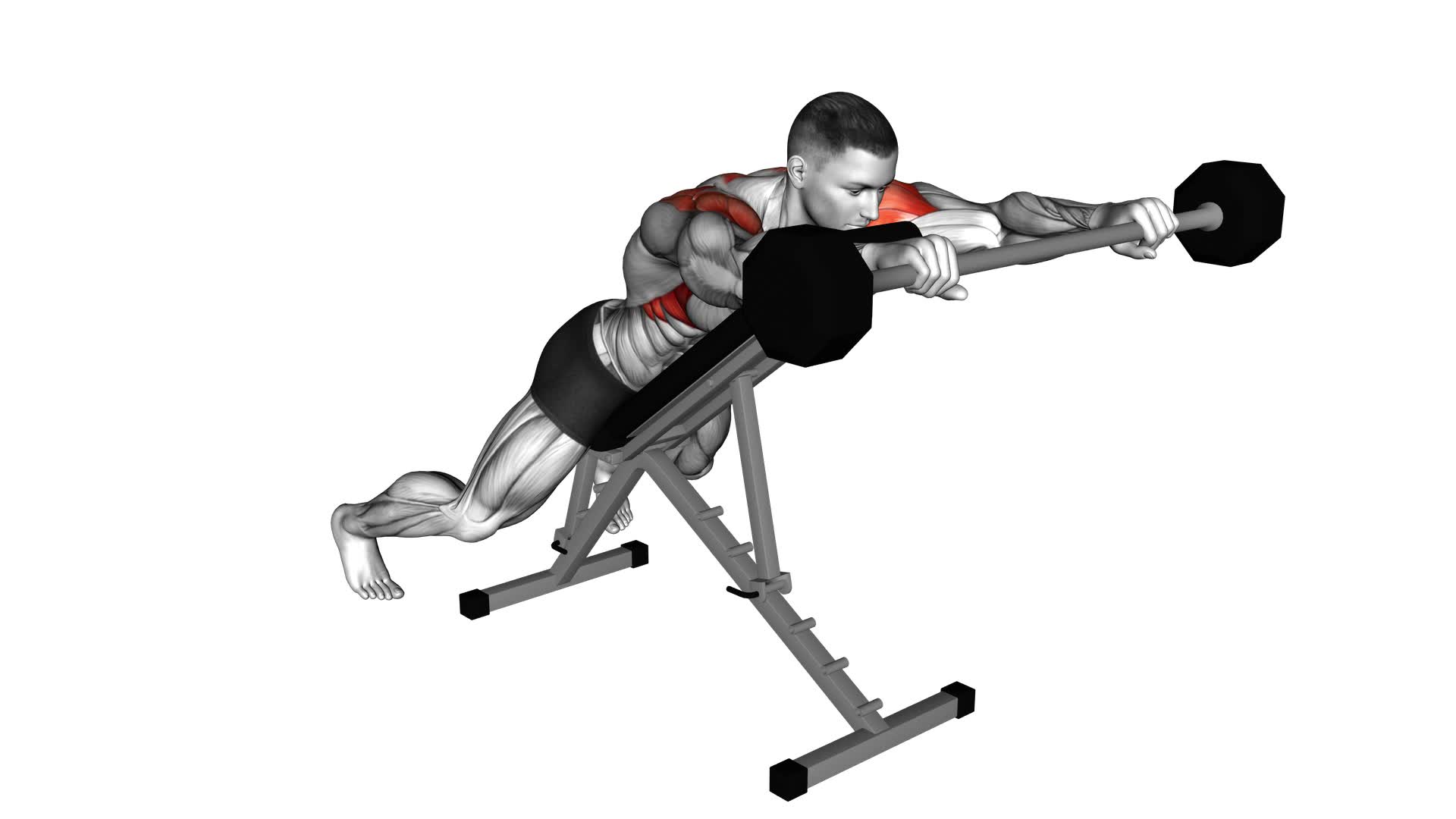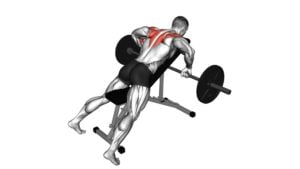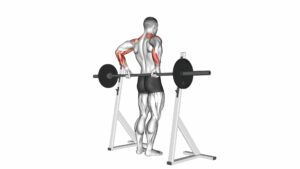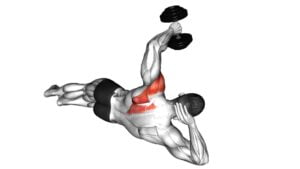Barbell Incline Lying Rear Delt Raise – Video Exercise Guide & Tips

Are you looking to target your rear delts and build strength in your upper body? Look no further than the Barbell Incline Lying Rear Delt Raise.
Watch This Exercise Video
This exercise is perfect for activating those hard-to-reach muscles and improving your overall shoulder stability.
In this video exercise guide, we'll show you the proper form and technique, as well as provide tips for maximizing your results.
Get ready to take your upper body workout to the next level. Let's get started!
Key Takeaways
- The Barbell Incline Lying Rear Delt Raise targets the rear delts and improves shoulder stability.
- Alternative exercises such as the Bent-over Dumbbell Rear Delt Raise and Cable Face Pulls can also effectively target the rear delts.
- Proper form and technique, including maintaining control and gradually increasing weight, are important for maximizing results.
- Consulting with a professional trainer or coach can help ensure proper form, reduce the risk of injury, and provide personalized guidance for rear delt training.
Benefits of the Barbell Incline Lying Rear Delt Raise
The Barbell Incline Lying Rear Delt Raise provides a range of benefits for your shoulders and upper back muscles. This exercise is specifically designed to target your rear delts, which are often neglected in traditional shoulder workouts. By incorporating the Barbell Incline Lying Rear Delt Raise into your routine, you can effectively activate and strengthen these muscles, improving your overall shoulder stability and posture.
One of the key benefits of this exercise is its ability to isolate the rear deltoid muscles. The inclined position allows for a greater range of motion, ensuring that your rear delts are fully engaged throughout the movement. This targeted muscle activation helps to enhance your shoulder strength and definition.
Additionally, the Barbell Incline Lying Rear Delt Raise also stimulates the upper back muscles, such as the rhomboids and trapezius. These muscles play a crucial role in maintaining proper posture and shoulder alignment. By strengthening these muscles, you can reduce the risk of shoulder injuries and improve your overall upper body strength.
Incorporating the Barbell Incline Lying Rear Delt Raise into your workout routine can provide numerous benefits for your shoulders and upper back muscles. By targeting the rear delts and other upper back muscles, you can improve muscle activation, enhance shoulder stability, and maintain proper posture.
Equipment Needed for the Exercise
To perform the Barbell Incline Lying Rear Delt Raise, you'll need a barbell and an incline bench. Here's the equipment you'll need for this exercise:
- Barbell: Choose a barbell that's appropriate for your fitness level and experience. Make sure it's long enough to comfortably hold with both hands and has a secure grip.
- Incline Bench: Find an incline bench that can be adjusted to a comfortable angle for your body. The incline should allow you to lie down with your chest supported and your head above your feet.
- Weight Plates: You'll need weight plates to load the barbell. Start with a weight that challenges your rear delt muscles without compromising your form.
- Collars: Secure the weight plates on the barbell with collars to prevent them from sliding off during the exercise.
When choosing the right weight for the exercise, consider your strength and fitness level. Start with a lighter weight and gradually increase as you become more comfortable with the movement. It's important to challenge yourself, but also maintain proper form and technique to avoid injury.
Now that you know what equipment you'll need, let's move on to the next section where we'll discuss the proper form and technique for the Barbell Incline Lying Rear Delt Raise.
Proper Form and Technique
Now, let's focus on how to execute the Barbell Incline Lying Rear Delt Raise with proper form and technique.
To perform this exercise correctly, start by setting an adjustable bench at a 45-degree angle. Lie face down on the bench, holding a barbell with an overhand grip. Keep your feet flat on the floor for stability.
To begin the movement, lift the barbell up towards the ceiling, leading with your elbows. Keep your arms slightly bent throughout the exercise. As you lift the barbell, focus on squeezing your shoulder blades together and engaging your rear deltoids.
It is important to avoid common mistakes while performing this exercise. One common mistake is using too much weight, which can lead to poor form and reduced muscle activation. Start with lighter weights to ensure proper form and gradually increase the weight as you become more comfortable.
Remember to maintain control and a slow, controlled pace throughout the exercise. Avoid using momentum to lift the weight, as this can shift the focus away from your rear deltoids.
Variations and Modifications
Try incorporating a single-arm variation of the Barbell Incline Lying Rear Delt Raise to target your rear deltoids even more effectively. This modification allows for increased focus on each side of your back, helping to correct any imbalances and improve overall symmetry.
Here are some other alternative exercises and modifications you can try to add variety to your rear deltoid workouts:
- Bent-over Dumbbell Rear Delt Raise: Stand with your feet hip-width apart, holding dumbbells in each hand. Bend forward at the waist, keeping your back straight. Raise your arms out to the sides, squeezing your shoulder blades together at the top of the movement. Slowly lower the weights back to the starting position.
- Cable Face Pulls: Attach a rope handle to a cable machine at shoulder height. Stand facing the machine and grab the rope with an overhand grip. Pull the rope towards your face, keeping your elbows high and squeezing your shoulder blades together. Slowly return to the starting position.
- Seated Rear Delt Fly: Sit on a bench with a dumbbell in each hand, arms extended straight down towards the floor. Raise your arms out to the sides, squeezing your shoulder blades together. Slowly lower the weights back to the starting position.
- Resistance Band Rear Delt Pull Apart: Stand with your feet shoulder-width apart, holding a resistance band in front of you with both hands. Pull the band apart, bringing your hands out to the sides and squeezing your shoulder blades together. Slowly release the tension and return to the starting position.
Remember to maintain proper form and avoid these common mistakes: using too much weight, swinging the weights, or shrugging your shoulders.
Tips for Maximizing Your Results
To maximize your results, incorporate these tips into your Barbell Incline Lying Rear Delt Raise routine.
- One common mistake is using too much weight and sacrificing proper form. It's important to start with a weight that allows you to maintain control throughout the exercise.
- Focus on squeezing your shoulder blades together as you raise the barbell, ensuring that your rear delts are doing the work.
- Another mistake is rushing through the exercise. Take your time and perform each rep with intention and control. This will engage your muscles more effectively and prevent injury.
In addition to the Barbell Incline Lying Rear Delt Raise, there are alternative exercises you can incorporate into your routine to further target your rear delts.
- One option is the Dumbbell Rear Delt Raise, where you can hold a dumbbell in each hand and raise them out to the sides while keeping a slight bend in your elbows.
- Another alternative is the Bent-Over Rear Delt Raise, where you bend at the waist with a dumbbell in each hand and raise your arms out to the sides.
These exercises can help add variety to your routine and ensure that you're effectively working your rear delts from different angles. Remember to always consult with a professional trainer or coach to ensure proper form and technique.
Frequently Asked Questions
How Often Should I Perform the Barbell Incline Lying Rear Delt Raise Exercise?
To maximize results and avoid overtraining, it's important to find the right frequency for the barbell incline lying rear delt raise exercise.
Depending on your fitness level and goals, performing this exercise 2-3 times a week could be beneficial. However, it's crucial to listen to your body and allow for proper recovery.
Remember to start with lighter weights and gradually increase the intensity to progress.
Avoid common mistakes like using momentum or arching your back for better results.
Can I Use Dumbbells Instead of a Barbell for This Exercise?
Yes, you can use dumbbells instead of a barbell for the exercise.
Using dumbbells for rear delt raises is a great alternative for rear deltoid training. It allows for a wider range of motion and targets the muscles in a slightly different way.
Dumbbells also provide the benefit of unilateral training, helping to correct any muscle imbalances.
Incorporating dumbbell rear delt raises into your routine can help you achieve well-rounded shoulder development.
Is It Normal to Feel Discomfort or Soreness in My Shoulders After Performing This Exercise?
Feeling discomfort or soreness in your shoulders after this exercise isn't uncommon. It can be a result of the muscles being worked and the increased shoulder mobility required for the movement.
However, if the discomfort persists or becomes severe, it's important to assess your form and technique. Make sure you're using an appropriate weight and performing the exercise with proper alignment.
Remember to listen to your body and adjust as needed.
What Muscles Does the Barbell Incline Lying Rear Delt Raise Target?
The barbell incline lying rear delt raise targets your rear deltoid muscles, which are located at the back of your shoulders. This exercise is great for strengthening these muscles and improving your overall shoulder stability.
If you experience discomfort or soreness after performing this exercise, it's important to listen to your body and modify or decrease the weight if needed. Alternatively, you can try different variations of this exercise to target your rear delts in a slightly different way.
Can This Exercise Help Improve My Posture?
Incorporating the barbell incline lying rear delt raise into your workout routine can have several benefits for improving your posture.
This exercise targets the rear deltoid muscles, which play a crucial role in maintaining proper shoulder alignment and stability.
To perform this exercise for maximum posture improvement, lie face down on an incline bench with a barbell in your hands.
Lift the barbell up and squeeze your shoulder blades together, then slowly lower it back down.
Repeat for the desired number of reps.
Conclusion
In conclusion, the barbell incline lying rear delt raise is a highly effective exercise for targeting and strengthening the rear deltoid muscles.
By using proper form and technique, along with variations and modifications, you can maximize your results and enhance your upper body strength.
Incorporating this exercise into your workout routine can help improve your overall shoulder stability and posture.
Remember to start with lighter weights and gradually increase the resistance as you progress.

Author
Years ago, the spark of my life’s passion ignited in my mind the moment I stepped into the local gym for the first time. The inaugural bead of perspiration, the initial endeavor, the very first surge of endorphins, and a sense of pride that washed over me post-workout marked the beginning of my deep-seated interest in strength sports, fitness, and sports nutrition. This very curiosity blossomed rapidly into a profound fascination, propelling me to earn a Master’s degree in Physical Education from the Academy of Physical Education in Krakow, followed by a Sports Manager diploma from the Jagiellonian University. My journey of growth led me to gain more specialized qualifications, such as being a certified personal trainer with a focus on sports dietetics, a lifeguard, and an instructor for wellness and corrective gymnastics. Theoretical knowledge paired seamlessly with practical experience, reinforcing my belief that the transformation of individuals under my guidance was also a reflection of my personal growth. This belief holds true even today. Each day, I strive to push the boundaries and explore new realms. These realms gently elevate me to greater heights. The unique combination of passion for my field and the continuous quest for growth fuels my drive to break new ground.







